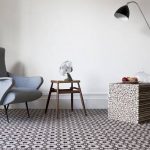WPC refers to “wood plastic composite” but oddly enough, there are very few WPC floors that contain any wood at all!
So what is all the hype about this fastest growing segment of the flooring industry? The short answer is these floors perform like laminate flooring, install quickly and easily like laminate flooring (no nails or glue), and are waterproof.
WPC can go over most subfloors without much preparation.
WPC floors refer to a category of Luxury Vinyl Plank and Luxury Vinyl Tile (LVT and LVP) that are rigid. Ordinary LVT/LVP flooring is constructed of 100% virgin vinyl but does not have the rigid thermoplastic core material of WPC floors. This rigid core material of WPC is beneficial when the existing subfloor has imperfections, so it cuts down the time and cost of subfloor preparation during installation. If a subfloor is not sufficiently smooth for ordinary LVT/LVP flooring, the imperfections could telegraph through the vinyl over time. So the bottom line difference between WPC and LVP is the ability of the rigid core to hide more subfloor imperfections.
The big advantage for WPC over laminate is that it is waterproof.
Plus the vinyl wear layer of WPC absorbs the impact sounds to make it inherently quieter than laminate (a good sound control underlayment for laminate will mitigate this difference)
 Pictured is the white thermoplastic core of Mohawk’s SolidTech
Pictured is the white thermoplastic core of Mohawk’s SolidTech
So what about the most important characteristic – looks, visual realism and authenticity compared to hardwood?
WPC floors are very good and will be rapidly improving over time. But the higher end and more mature laminate flooring brands which have unique characteristics like big beveled edges and extremely realistic in-register embossing (when the surface texture follows the relief and the grain of the wood), are in our opinion, a step ahead in visual realism at this time.
You can find many new WPC floors in our Vinyl Flooring section.
